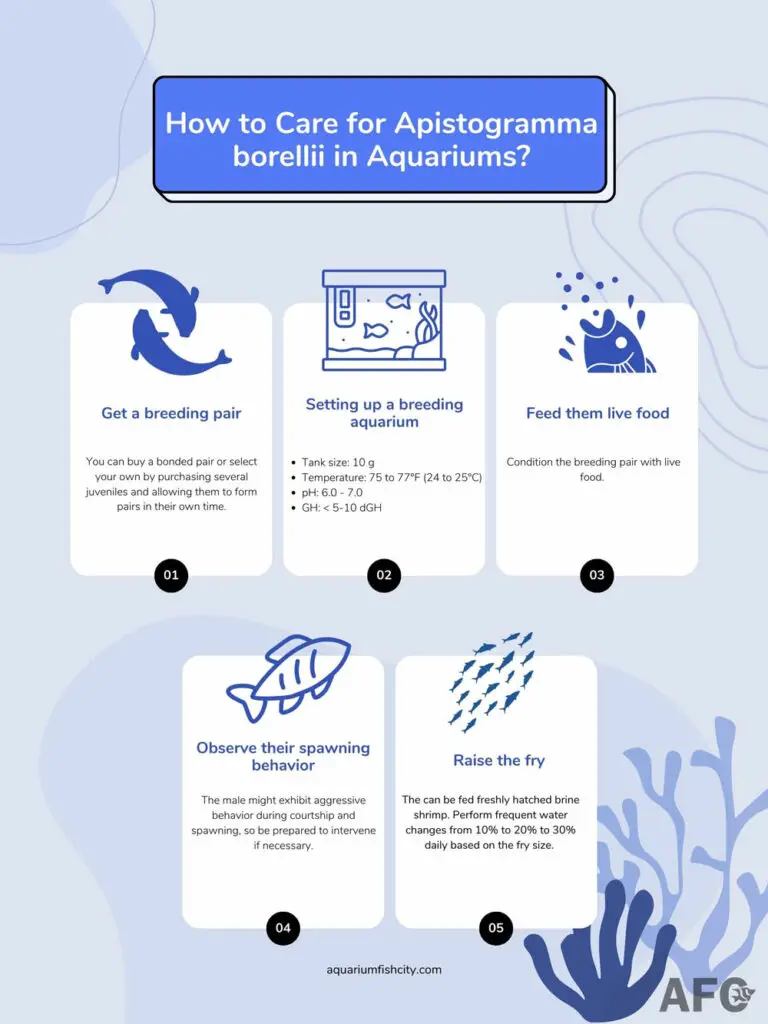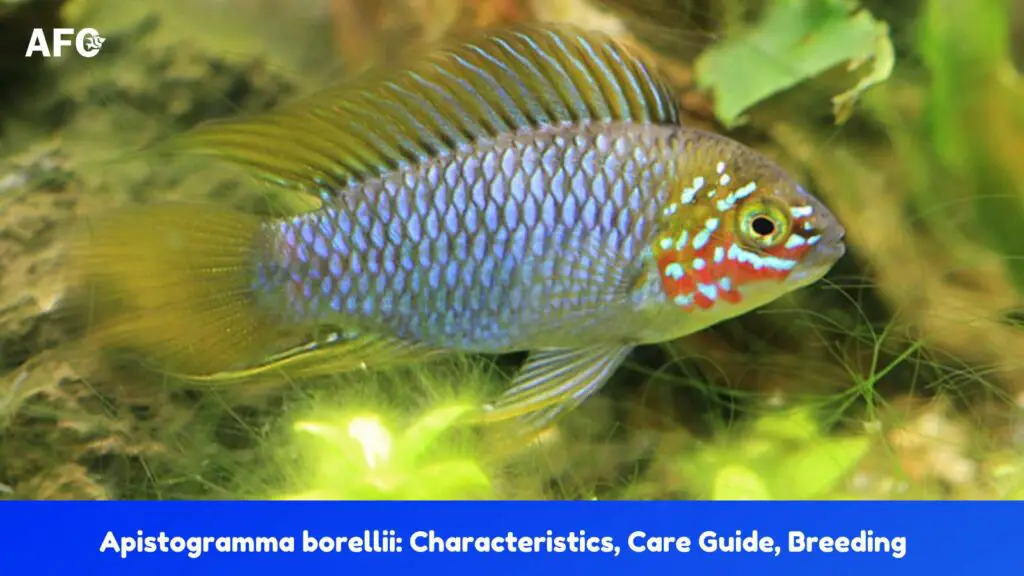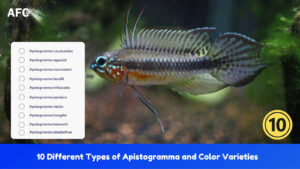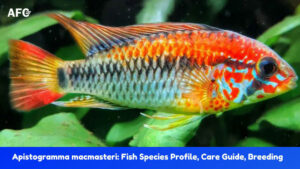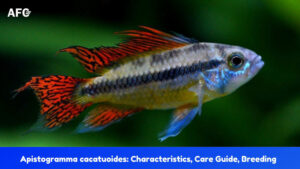Apistogramma borellii, also known as the yellow dwarf cichlid or umbrella cichlid, stands out as not only one of the most colorful Apistogramma species but also one of the hardiest and easiest to care for in a home aquarium.
Yellow dwarf cichlids display two striking colors: opal and blue. Males and females show few apparent differences between the sexes.
Being the #1 beginner Apistogramma cichlid, Apistogramma borellii is a small, peaceful cichlid that gets along well with other fish and adapts to a wide range of water conditions, particularly colder temperatures.
Read on to learn more about the yellow dwarf cichlid, including how to care for it and breed it in the home aquarium.
What is Apistogramma borellii?
Apistogramma borellii is a two-part scientific name given to the recognized freshwater tropical fish species that is commonly known by hobbyists as the yellow dwarf cichlid or umbrella cichlid. The species name borellii is named after Dr. Alfredo Borelli, who collected the first specimen of this species.
It was first described in 1906 by Dr. Charles Tate Regan but was misidentified as many other species for decades before being finally described as Apistogramma borellii by R. Sven Kullander in 1983.
As with many other Apistogramma species, several closely related forms of A. borellii exist in the wild. A. borellii is thought to be a representative of the Apistogramma borellii complex within the Apistogramma regani lineage.
Members of the A. borellii complex can be spotted by their tall, sail-shaped dorsal fins and rounded, spade-shaped tail. Their bodies are deep and narrow. Most specimens also have a distinctive zigzag-shaped band running laterally down the back half of their bodies.
What Are the Types of Apistogramma borellii?
Here are the two most popular types of Apistogramma borellii.
- Apistogramma borellii ‘Opal’
- Apistogramma borellii ‘Blue’
Apistogramma borellii ‘Opal’
Apistogramma borellii ‘Opal’ is a beautiful color morph of the Apistogramma borellii. The name ‘Opal’ was originally used to refer to a domestic strain of A. borellii that was bred in East Germany during the 1960s and 1970s. The original strain was lost over the decades, but similar wild forms can still be found.
The most distinctive feature of Apistogramma borellii ‘Opal’ is the brilliant yellow dorsal, caudal, and anal fins. The body color can vary from a pale purple hue to a more intense shade of blue. The gill cover is the most vibrant part of the fish, with mottled red, yellow, and blue markings that give it an opalescent appearance.
Apistogramma borellii ‘Blue’
A. borellii ‘Blue’ is the more common morph of Apistogramma borellii in the aquarium trade. It has a deep, vibrant blue coloration on the body and fins, with the head almost entirely yellowish. The fins are also edged in yellow, giving the fish a striking and colorful appearance.
What Are the Differences Between A. borellii ‘Blue’ Versus’ Opal’?
The main differences between Apistogramma borellii ‘Blue’ and ‘Opal’ are their body colors and facial markings. A. borellii ‘Blue’ is known for its deep blue body and entirely yellow head, while A. borellii ‘Opal’ exhibits a pale purple or blue body along with red, yellow, and blue mottled markings on the gill cover.
How to Tell a Male From a Female Apistogramma borellii?
Apistogramma borellii males are usually a bit larger, more vibrantly colored, and have more pointed dorsal and anal fins than females. Females, on the other hand, develop a black area on the front of the pelvic fin. Young fish smaller than 1.4 inches (3.5 cm) are too small to determine gender accurately.
How Big do Apistogramma borellii Get?
Apistogramma borellii grows to a maximum standard length (SL) of 2 inches (5.1 cm), according to the Check List of the Freshwater Fishes of South and Central America hardcover by Sven O. Kullander and Roberto E. Reis.
However, because of their round, fan-shaped tails, they rarely exceed 2.6 inches (6.5 cm) in total length (TL), which includes the length of the caudal fin. This measurement is less reliable because the length of the tail fin can vary depending on the individual fish, sometimes even being damaged.
Are Apistogramma borellii Aggressive?
No, A. borellii is a peaceful Apistogramma species because they are casually monogamous fish, meaning a male will happily form a bond with a female, but these pair bonds can be transitory if an opportunity arises.
Unlike males of highly polygamous species, like A. macmasteri, A. cacatuoides, or A. agassizii, A. borellii males are not too picky about their partners.
How Long Do Apistogramma borellii Live?
The average lifespan of Apistogramma borellii is approximately two years, according to a 1991 statistical study by Dr. Uwe Römer. However, some hobbyists have reported that they have lived up to five years in captivity if kept in optimal environments that match their natural habitat as closely as possible.
Where Do Apistogramma borellii Come From?
Apistogramma borellii originates from a wide variety of native habitats of the middle-upper Paraguay River and Paraná River of Brazil, Bolivia, Paraguay, Argentina, and Uruguay, where a variety of water conditions exist. These waterways are usually beneath dense rainforests and let very little light through.
Their range actually extends far south than other Apistogramma species, and some wild populations have been collected in lagoons with temperatures as low as 50°F (10°C).
For this reason, they are not demanding about water parameters and can handle a huge range of temperatures, pH, and hardness. It’s no wonder that they are one of the easiest Apistos in the hobby.
How to Take Care of Apistogramma borellii?
Here are some general guidelines to help you provide the best care for Apistogramma borellii.
- Set Up a Larger Tank
The minimum tank size for a single pair of A. borellii is 10 gallons (38 liters). A 29-gallon tank is a good size for a half-dozen juveniles if you intend to select your own breeding pair. As with any Apistogramma, larger is always better.
Aquariums come in many shapes but stick with wider, longer tanks that provide more bottom surface area for territories.
Contrary to popular belief, small aquariums are challenging to maintain for beginners. This is because water chemistry, such as ammonia, nitrite, and pH levels, can spike quickly in small water volumes and leave no room for error. Go for tanks larger than 20 gallons until you become experienced.
- Optimize Water Quality Parameters
The best aquarium water parameters for Apistogramma borellii are as follows.
- Water temperatures: 72 to 77 °F (22 to 25 °C)
- pH: 6.0 to 8.0
- GH: 5 to 19 dGH
Yellow dwarf cichlids are hardy enough to tolerate cooler temperatures and harder waters, but they prefer slightly acidic and very soft water. This is especially important when attempting to breed them.
Perform regular partial water changes of about 10-15% weekly to maintain stable water chemistry.
- Choose Compatible Tank Mates
Listed below are some good tank mates for Apistogramma borellii.
- Small South American tetras: These are a group of diminutive, brightly colored, shoaling fish that are native to the clear water and blackwater rivers in South America. Some popular species include neon tetra, green neon tetra, black neon tetra, cardinal tetra, and ember tetra. They usually move between the middle and top of the water volume and prefer similar water conditions. These fish must be kept in shoaling groups of at least a half-dozen or more.
- Small South American catfish: These are a group of tiny, peaceful, and playful bottom-dwelling fish that originate from South America. The most commonly kept species are Corydoras catfish and Otocinclus catfish, which are known for their excellent cleaning skills. Like Apistogramma borellii, they also appreciate cooler temperatures and softer waters. Keep them in groups of at least three of the same species so they feel safe.
- Freshwater hatchetfish: This is a group of top-dwelling South American fish that range from 1 to 2.5 inches (2.5 to 6 cm) in length. They get the common name from their unique, hatchet-shaped body and wing-like pectoral fins. As shoaling fish, they like to be kept in a big group of at least 10 individuals of the same species.
- Pencilfish: It is a group of surface-dwelling fish from the Nannostomus genus. They are distant relatives of the tetra, but they have a small mouth, making them safe for Apistogramma borellii babies. Many pencilfish are known for their ability to swim diagonally at a 45-degree angle. They live in large schools, so keep them in groups of 6 or more of the same species.
- Small, relatively peaceful South American cichlids: These are a few small, peaceful cichlids from South America that can peacefully coexist with Apistogramma borellii when raised together from a young age in large community tanks. Examples include Angelfish, keyhole cichlids, Discus, Ram cichlids, and Geophagus.
- Add Appropriate Decorations to The Tank
Decorating the aquarium with live plants, a sandy substrate, driftwood, and caves will give Apistogramma borellii a greater sense of comfort.
When selecting live plants for the aquarium, easy-to-grow floating plants like American frogbit, giant salvinia, water cabbage, and Indian pennywort are particularly desirable. These freshwater aquarium plants bring many positive effects to any tank, from diffusing light to oxygenating water to enhancing aesthetic appeal.
A fine-grained, sandy substrate is best, as it allows Apistogramma borellii to sift through it for food without getting injured. Additionally, as with other Apistogramma species, the substrate should be dark in color to help the fish display their beautiful colors more vibrantly.
While yellow dwarf cichlids are community fish, the males can sometimes be a bit feisty during courtship and spawning, so provide plenty of hiding spots, such as flowerpots, driftwood, halved coconuts, or plastic piping.
- Feed A Variety of Live Foods
Apistogramma borellii primarily eats worms, crustaceans, and insects in the wild.
In captivity, they relish live foods. Good choices include live brine shrimp and daphnia, which can provide enough roughage with their exoskeletons, as well as protein sources such as bloodworms, glassworms, and mosquito larvae.
Apistogramma fish owners often ignore live red worms and blackworms because they can carry parasites and diseases and quickly contribute to poor water quality.
Captive-bred specimens can be trained to take prepared foods such as pellets or flakes, though they should also be given a variety of live treats to ensure complete nutrition.
When feeding Apistogramma borellii, it’s important to keep in mind that these fish will benefit from small portions spread throughout the day rather than one larger meal.
Why Yellow Dwarf Cichlids Are the #1 Beginner-friendly Apistogramma for Beginners?
Yellow dwarf cichlids are the #1 beginner-friendly Apistogramma species because of the following reasons.
- They are relatively small and do not require a large tank.
- They are casually monogamous and peaceful, so they can be kept in pairs with other compatible fish.
- They are hardy and can tolerate a range of water parameters, especially temperatures.
- They are colorful and attractive fish, making them a pleasure to watch.
- They are relatively inexpensive, making them a good option for budget-minded aquarists.
- They are easy to breed, requiring less effort and expertise than other Apistogramma.

How to Breed Apistogramma borellii?
These are the basic needs and steps you can follow to increase the likelihood of umbrella cichlid (Apistogramma borellii) breeding.
Step 1: Get a breeding pair
Umbrella cichlids are relatively easy to breed as pairs. You can buy a bonded pair or select your own by purchasing several juveniles and allowing them to form pairs in their own time.
Step 2: Setting up a breeding aquarium
To ensure success, a separate breeding tank is important. A 10-gallon tank is a good size for a spawning setup. The tank must be cycled and matured with a water temperature of 75 to 77°F (24 to 25°C), a pH level of 6.0 to 7.0, and water hardness of 5 to 10 dGH.
Umbrella Cichlids are cave spawners, meaning the female will find some cave in which to deposit her eggs. Make sure to give them the perfect spawning caves to breed just as they would do in nature. Upturned flowerpots and halved coconuts are the most widely used among breeders.
Use a depth of at least two inches of sandy substrate with plenty of leaf litter. The brooding female likes to pile up sand in front of her spawning site to block the entrance and protect her eggs.
Add 2 – 3 dwarf pencilfish (N. marginatus). This species is not a strictly shoaling fish and can stimulate the female during brood care.
Step 3: Feed them live food
Condition the breeding pair with live food. You can also raise the temperature a few degrees to signal a change in the season.
Step 4: Observe their spawning behavior
The spawning process often takes place secretly within the cave, where the female will lay approximately 50 to 70 eggs on the inside surface of the cave.
In about 2 to 4 days, the eggs will hatch and continue developing. After an additional 5 to 6 days, the fry will become free-swimming on their own.
The male might exhibit aggressive behavior during courtship and spawning, so be prepared to intervene if necessary.
Step 5: Raise the fry
At this stage, they can be fed freshly hatched brine shrimp, which will provide them with the necessary nutrients for healthy growth. Perform frequent water changes, from 10% to 20% to 30% daily, depending on the fry size.
Apistogramma borellii has a slow growth rate compared to most Apistogramma, and it might take up to 6 months for them to reach adulthood.
